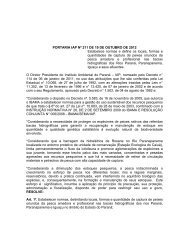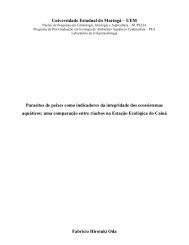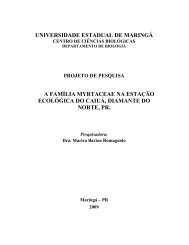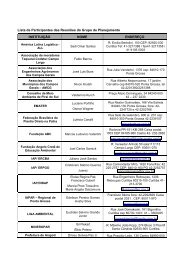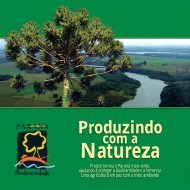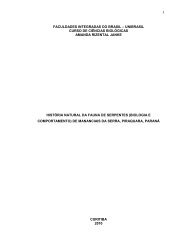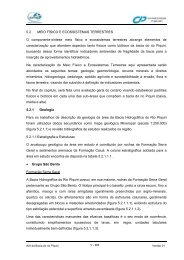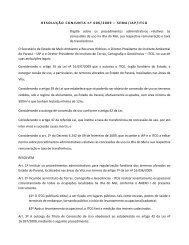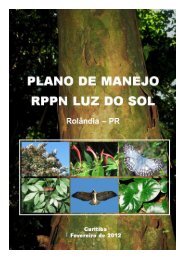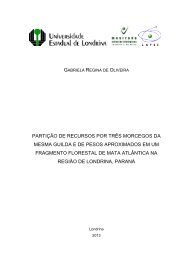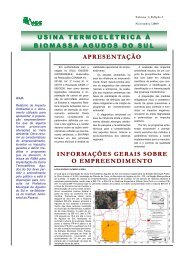Geographical distribution of Aegla schmitti Hobbs III, 1979 ...
Geographical distribution of Aegla schmitti Hobbs III, 1979 ...
Geographical distribution of Aegla schmitti Hobbs III, 1979 ...
You also want an ePaper? Increase the reach of your titles
YUMPU automatically turns print PDFs into web optimized ePapers that Google loves.
Nauplius 18(1): 45‑55, 2010 45<br />
<strong>Geographical</strong> <strong>distribution</strong> <strong>of</strong> <strong>Aegla</strong> <strong>schmitti</strong> <strong>Hobbs</strong> <strong>III</strong>, <strong>1979</strong><br />
(Decapoda Anomura Aeglidae) and morphometric variations in<br />
male populations from Paraná State, Brazil<br />
André Trevisan and Setuko Masunari<br />
(AT, SM) Department <strong>of</strong> Zoology, Institute <strong>of</strong> Biological Sciences, Federal University <strong>of</strong> Paraná. Centro Politécnico, Jardim das<br />
Américas, Caixa Postal 19020, 81531‑980, Curitiba, Paraná, Brazil.<br />
(AT) E‑mail: andretrevisan@ufpr.br.<br />
Abstract<br />
Introduction<br />
<strong>Geographical</strong> <strong>distribution</strong> <strong>of</strong> the freshwater anomuran <strong>Aegla</strong> <strong>schmitti</strong> and the<br />
morphometric variation among populations from different streams <strong>of</strong> Paraná State that<br />
are separated by Serra do Mar mountains were studied. The study was based on specimens<br />
deposited at Museum <strong>of</strong> Natural History <strong>of</strong> Capão da Imbuia (MHNCI) and on the<br />
literature. For morphometric analyses, the following dimensions were obtained from<br />
adult male specimens: cephalothorax length, rostrum length, rostrum base width, frontal<br />
width, cephalic area length, pre‑cervical width, carapace maximum width, longest chelar<br />
propodus length, widest chelar propodus width, telson length and its maximum width.<br />
Principal Components Analysis (PCA) and Discriminant Function Analysis (DFA)<br />
were used to discriminate morphometric differences among populations. Fourteen new<br />
records were obtained for A. <strong>schmitti</strong> in Paraná State, and its occurrence limits were<br />
extended to the municipality <strong>of</strong> Matinhos (to East), but remained to Ponta Grossa (to<br />
West), to Iporanga (to North) and Canoinhas (to South). PCA analysis formed four<br />
main groups, two <strong>of</strong> them including specimens from Matinhos River and Guaricana<br />
Hydroelectric Dam (rivers east <strong>of</strong> Serra do Mar mountains), a central one composed <strong>of</strong><br />
populations from Mato Grande, Piraquara and Iraí River B (downstream) (rivers west <strong>of</strong><br />
Serra do Mar mountains) and the last one formed by animals from Iraí River A (upland<br />
stream) (rivers west <strong>of</strong> Serra do Mar mountains). The results suggest that reproductive<br />
isolation <strong>of</strong> the populations, which are submitted to diverse abiotic variables, can be<br />
provoking morphometric alterations at least in males <strong>of</strong> A. <strong>schmitti</strong>.<br />
Key words: Aeglidae, intraspecific variations, Paraná State, Brazil.<br />
The unique freshwater anomuran genus <strong>Aegla</strong><br />
Leach, 1820 has over 60 species whose distribu‑<br />
tion is limited to the Neotropical Region <strong>of</strong> South<br />
America, from south <strong>of</strong> Minas Gerais State in Bra‑<br />
zil to southern Chile (Bond‑Buckup et al., 2008;<br />
Santos et al., 2009).<br />
Taxonomic studies <strong>of</strong> these crabs have been<br />
initiated approximately sixty years ago with<br />
Schmitt (1942) who described fifteen new spe‑<br />
cies and their geographical <strong>distribution</strong>. Later,<br />
Argentinean species have been recorded (Ringue‑<br />
let, 1949; Lopretto, 1978a, 1978b, <strong>1979</strong>, 1980a,<br />
1980b) and six new species were described from<br />
Rio Grande do Sul State from Brazilian waters<br />
(Buckup and Rossi, <strong>1979</strong>). These authors de‑<br />
scribed the geographical <strong>distribution</strong> <strong>of</strong> the genus<br />
and the occurrence <strong>of</strong> sympatric species. Bond‑<br />
Buckup (1994) carried out an extensive revision <strong>of</strong><br />
the family Aeglidae, including identification keys,<br />
diagnoses, measures, geographical <strong>distribution</strong> and<br />
description <strong>of</strong> 20 new species.<br />
More recently, the natural history, popula‑<br />
tion dynamics and evolution <strong>of</strong> aeglids have been<br />
studies by several authors (Bahamonde and Lopez,<br />
1961; Lopez, 1965; Rodrigues and Hebling, 1978;<br />
Bueno and Bond‑Buckup, 2000; Swiech‑Ayoub<br />
PROOF • PROOF • PROOF
46 Trevisan, A. and Masunari, S.: Distribution and morphometric variation in A. <strong>schmitti</strong><br />
and Masunari, 2001a, b; Noro and Buckup, 2002;<br />
Pérez‑Losada et al., 2004; Colpo et al., 2005; Gon‑<br />
çalves et al., 2006; Teodósio and Masunari, 2009).<br />
Morphometric research in aeglids is usually<br />
related to the relative growth, in which some di‑<br />
mensions especially those <strong>of</strong> secondary sexual char‑<br />
acters grow faster than others (Colpo et al., 2005;<br />
Viau et al., 2006 and Bueno and Shimizu, 2008;<br />
2009). These authors showed that species can initi‑<br />
ate a differential growth <strong>of</strong> the chelae in the males,<br />
and <strong>of</strong> the abdomen in the females when passing<br />
from juvenile to adult stage, in a pattern described<br />
by Hartnoll (1974; 1978; 1982).<br />
Intraspecific variations in body dimension<br />
were only studied in <strong>Aegla</strong> uruguayana Schmitt,<br />
1942 from Uruguay: the cephalothorax lengths<br />
<strong>of</strong> three different populations were analyzed, but<br />
no significant differences were found (Vaz‑Ferreira<br />
et al., 1945). However, these variations are well<br />
known in some groups <strong>of</strong> crustaceans such as cari‑<br />
dean and penaeid shrimps that can also be related<br />
to sexual dimorphism (Kapiris and Thessalou‑Le‑<br />
gaki, 2001; Tzeng et al., 2001; Tzeng, 2004; Anas‑<br />
tasiadou et al., 2004; Anastasiadou and Leonardos,<br />
2008; Anastasiadou et al., 2009). On the other<br />
hand, sexual dimorphism in aeglids is well known<br />
(Bueno et al., 2000; Colpo et al., 2005; Viau et al.,<br />
2006; Bueno and Shimizu, 2009).<br />
There are seven species <strong>of</strong> <strong>Aegla</strong> recorded for<br />
Paraná State (Bond‑Buckup and Buckup, 1994;<br />
Bond‑Buckup, 2003) and the biology <strong>of</strong> these<br />
species are poorly known in Paraná area since the<br />
studies are limited to the population structure <strong>of</strong><br />
<strong>Aegla</strong> castro Schmitt, 1942 (Swiech‑Ayoub and<br />
Masunari, 2001a, b) and <strong>Aegla</strong> <strong>schmitti</strong> <strong>Hobbs</strong> <strong>III</strong>,<br />
<strong>1979</strong> (Teodósio and Masunari, 2009). According<br />
to Bond‑Buckup (1994), A. <strong>schmitti</strong> is the most<br />
common and largely distributed aeglid species in<br />
this area; its geographical <strong>distribution</strong> is limited<br />
from Iporanga city, São Paulo State (northern lim‑<br />
it) to the municipality <strong>of</strong> Canoinhas, Santa Catari‑<br />
na State (southern limit) and from Guaratuba city<br />
(eastern limit) to Ponta Grossa city (western limit).<br />
Based on the deposited lots <strong>of</strong> aeglids in the<br />
Museum <strong>of</strong> Natural History <strong>of</strong> the Capão da Im‑<br />
buia (MHNCI) and a literature review (Bond‑<br />
Buckup and Buckup, 1994; Bond‑Buckup, 2003)<br />
the present work aims to update the geographical<br />
<strong>distribution</strong> <strong>of</strong> this species in Paraná State. Addi‑<br />
tionally, it is proposed to explore morphological<br />
variations within male populations coming from<br />
streams and rivers located on both sides <strong>of</strong> Serra do<br />
Mar mountains which is an important geographi‑<br />
cal barrier in Paraná State.<br />
Material and Methods<br />
<strong>Geographical</strong> <strong>distribution</strong><br />
The geographical <strong>distribution</strong> <strong>of</strong> A. <strong>schmitti</strong><br />
was obtained from the literature and was updated<br />
based on the deposited specimens in MHNCI,<br />
Curitiba city. The specimens were identified with<br />
the aid <strong>of</strong> identification keys and diagnoses from<br />
Bond‑Buckup (1994, 2003) and a <strong>distribution</strong><br />
map was elaborated using the program ArcView<br />
GIS 3.2.<br />
Whenever geographical coordinates <strong>of</strong> the<br />
collection site were not available, data from a spe‑<br />
cialized internet site (Species link) that show geo‑<br />
graphical coordinates <strong>of</strong> deposited specimens in<br />
scientific collections were used. If missing record<br />
<strong>of</strong> the exact collection stream occurred only the<br />
municipality name and coordinate were used as<br />
the reference point.<br />
Examined material [municipality, river, collection<br />
date (collector), number <strong>of</strong> males (m), females (f),<br />
ovigerous female (fov) or juvenile (juv), (lot)]:<br />
Quatro Barras, Taquari River, 04‑09.x.1987 (Cury,<br />
M.R. and Wosiacki, W.B.) 2 f, 3 m, (371); Iraí<br />
River, 13.ix.1991 (Grandó, E.T.), 2 f, 4 m, (454);<br />
Iraí River, xi.1998 (Abilhôa, V. and Moura Leite,<br />
J.C.), 32 m, (484); Araucária, Guajuvira River,<br />
08.iii.1992 (Wosiacki, W.B.), 2 m, (452); Passaú‑<br />
na River, 23.ix.1966 (Cordeiro, A.M. and Ri‑<br />
beiro, J.C), 1 f, 5 m, (938); Passaúna River, 23.<br />
ix.1966 (Cordeiro, A.M. and Ribeiro, J.C.), 1 f,<br />
(939); Passaúna River, 23.ix.1966 (Cordeiro,<br />
A.M. and Ribeiro, J.C.), 1 m, (947); Passaúna<br />
River, 23.ix.1966 (Cordeiro, A.M. and Ribeiro,<br />
J.C.), 6 f, 1 fov, 3 m (1128); Piraquara, Iraí River,<br />
31.x.1991 (Cordeiro, A.A. and Grandó E.T.), 4 f,<br />
6 m (456); Iraí River, 17.x.1964 (Alexandre, Z.),<br />
1 m, (561); Iraí River, 17.x.1964 (Alexandre, Z.),<br />
1 m, (563); Iraí River, 17.x.1964 (Alexandre, Z.),<br />
1 m, (567); Iraí River, 17.x.1964 (Alexandre, Z.),<br />
1 fov, (568); Iraí River, 17.x.1964 (Alexandre, Z.),<br />
1 f, (573); Iraí River, 17.x.1964 (Alexandre, Z.),<br />
1 f, (574); Iraí River, 17.x.1964 (Alexandre, Z.),<br />
1 m, (575); Mato Grande River, no date (no col‑<br />
lector), 1 m, (671); Iraí River, 25.xi.1998 (Abil‑<br />
hôa, V.), 16 m, (814); Mato Grande River, 21.<br />
PROOF • PROOF • PROOF
Nauplius 18(1): 45‑55, 2010 47<br />
vi.1983 (Dambrós, A. and Ribeiro, J.C.), 1 m,<br />
(836); Mato Grande River, 21.vi.1983 (Dambrós,<br />
A. and Ribeiro, J.C.), 1 m, (838); Mato Grande<br />
River, 21.vi.1983 (Dambrós, A. and Ribeiro,<br />
J.C.), 1 m, (839); Iraí River, 11.viii.1967 (Alexan‑<br />
dre, Z.), 1 fov, (1073); Iraí River, 27.vii.1967 (Al‑<br />
exandre, Z.), 1 m, (1075); Iraí River, 11.viii.1967<br />
(Alexandre, Z.), 1 m, (1079); Iraí River, 11.<br />
viii.1967 (Alexandre, Z.), 1 m, (1084); Iraí River,<br />
27.vii.1967 (Alexandre, Z.), 1 m, (1109); Iraí<br />
River, 27.vii.1967 (Alexandre, Z.), 1 m, (1121);<br />
Iraí River, 25.xi.1998 (Abilhôa, V.), 13 m, (1122);<br />
Iraí River, 27.vii.1967 (Alexandre, Z.), 1 m,<br />
(1124); Iraí River, 27.vii.1967 (Alexandre, Z.),<br />
1 m, (1126); Iraí River, 27.vii.1967 (Alexandre,<br />
Z.), 1 f, (1131); Piraquara River, 21.viii.1983<br />
(Dambrós, A. and Ribeiro, J.C.), 1 m, (1210); Iraí<br />
River, v.<strong>1979</strong> (Nogueira, M.H.), 2 f, 2 m, (1259);<br />
Mato Grande River, 21.vi.1983 (Dambrós, A. and<br />
Ribeiro, J.C.), 6 m, (1722); Mato Grande River,<br />
14.iv.1983 (Dambrós, A. and Ribeiro, J.C.), 5 f,<br />
10 m, (1737); Mato Grande River, 14.iv.1983<br />
(Dambrós, A. and Ribeiro, J.C.), 3 f, 10 m,<br />
(1738); Mato Grande River, 14.iv.1983 (Ribeiro,<br />
J.C.), 1 m, (1739); Mato Grande River, 14.<br />
iv.1983 (Ribeiro, J.C.), 1 m, (1740); Mato Grande<br />
River, 14.iv.1983 (Ribeiro, J.C.), 1 m, (1741);<br />
Mato Grande River, 14.iv.1983 (Ribeiro, J.C.),<br />
1 m, (1742); Mato Grande River, 14.iv.1983<br />
(Dambrós, A. and Ribeiro, J.C.), 2 f, (1743);<br />
Mato Grande River, 14.iv.1983 (Dambrós, A. and<br />
Ribeiro, J.C.), 1 f, (1744); Mato Grande River,<br />
14.iv.1983 (Dambrós, A. and Ribeiro, J.C.), 1 f,<br />
(1745); Piraquara River, 25.viii.1983 (Dambrós,<br />
A. and Ribeiro, J.C.), 32 m, (1773); Piraquara<br />
River, 25.viii.1983 (Dambrós, A. and Ribeiro,<br />
J.C.), 1 m, (1801); Piraquara River, 25.viii.1983<br />
(Dambrós, A. and Ribeiro, J.C.), 1 m, (1802); Pi‑<br />
raquara River, 25.viii.1983 (Dambrós, A. and Ri‑<br />
beiro, J.C.), 1 m, (1803); Piraquara River, 25.<br />
viii.1983 (Dambrós, A. and Ribeiro, J.C.), 1 m,<br />
(1804); Piraquara River, 25.viii.1983 (Dambrós,<br />
A. and Ribeiro, J.C.), 1 f, (1805); Piraquara River,<br />
25.viii.1983 (Dambrós, A. and Ribeiro, J.C.), 1 f,<br />
(1806); São José dos Pinhais, Miringuava River,<br />
01.vii.1997 (Lopes, O.L.; Santos, C.S. and Sasa‑<br />
oka, S.K.), 2 f, 1 m, (463); Miringuava River,<br />
01.viii.1997 (Lopes, O.L.; Santos, C.S. and Sasa‑<br />
oka, S.K.), 1 f, 2 m, (465); Miringuava River,<br />
01.ix.1997 (Lopes, O.L.; Santos, C.S. and Sasao‑<br />
ka, S.K.), 2 f, (468); Miringuava River, 01.x.1997<br />
(Lopes, O.L.; Santos, C.S. and Sasaoka, S.K.), 1 f,<br />
(469); Miringuava River, 01.xii.1997 (Lopes,<br />
O.L.; Santos, C.S. and Sasaoka, S.K.), 1juv, (470);<br />
Miringuava River, 01.vi.1998 (Torres, J.D. and<br />
Lopes, O.L.), 1 m, (480); Miringuava River,<br />
30.ix.1998 (Torres, J.D. and Lopes, O.L.), 1 f,<br />
2 m, (481); Guaricana Dam, 17.vii.1988 (Wosia‑<br />
cki, W.B.), 1 m, (512); Miringuava River, 18.<br />
vii.2001 (Abrilhôa, V.), 1 f, 10 m, (801); Mirin‑<br />
guava River, 18.vii.2001 (Abrilhôa, V.), 1 f, (804);<br />
Miringuava River, 18.vii.2001 (Abrilhôa, V.), 4 f,<br />
4 m, (806); Guaricana Creek, 27.ii.1985 (Dam‑<br />
brós, A. and Ribeiro, J.C.), 1 m, (808); Guaricana<br />
Creek, 26.ii.1985 (Ribeiro, J.C.), 1 m, (832);<br />
Guaricana Creek, 26.ii.1985 (Ribeiro, J.C.), 1 m,<br />
(833); Miringuava River, 04.x.2001 (Abrilhôa,<br />
V.), 1 m, (860); Guaricana Dam, 27.ii.1985<br />
(Dambrós, A. and Ribeiro, J.C.), 2 f, 1 m, (1119);<br />
Guaricana Creek, 26.ii.1985 (Dambrós, A. and<br />
Ribeiro, J.C.), 10 m, (1317); Miringuava River,<br />
26.x.1983 (Dambrós, A. and Ribeiro, J.C.), 1 f,<br />
1 m, (1684); Miringuava River, 26.x.1983 (Dam‑<br />
brós, A. and Ribeiro, J.C.), 1 f, 1 m, (1685); Mir‑<br />
inguava River, 26.x.1983 (Dambrós, A. and Ri‑<br />
beiro, J.C.), 1 m, (1686); Miringuava River,<br />
26.x.1983 (Dambrós, A. and Ribeiro, J.C.), 2 m,<br />
(1687); Miringuava River, 26.x.1983 (Dambrós,<br />
A. and Ribeiro, J.C.), 2 m, (1688); Miringuava<br />
River, 26.x.1983 (Dambrós, A. and Ribeiro, J.C.),<br />
2 m, (1689); Guaricana Creek, 01.x.1985 (Car‑<br />
neiro, A. and Ribeiro, J.C.), 3 f, 1 m, (1849); Cu‑<br />
ritiba, Passaúna River, 06.iii.1963 (Nogueira,<br />
M.H.), 1 m, (487), no name, 18.xi.1972 (Noguei‑<br />
ra, M.H.), 1 f, 1 m, (525); Passaúna River, 17.<br />
vii.1991 (Vivikamanda, Vital and Vital), 1 m,<br />
(858); Pinhais, Iraí River, 17.x.1964 (Alexandre,<br />
Z.), 1 m, (505); Iraí River, 17.x.1964 (Alexandre,<br />
Z.), 1 m, (511); Iguaçu River, 01.v.1967 (Alexan‑<br />
dre, Z.), 1 m, (514); Iraí River, 17.x.1964 (Alex‑<br />
andre, Z.), 7 m, (570); Iraí River, 27.vii.1967 (Al‑<br />
exandre, Z.), 3 f, 20 m, (693); Iraí River, 27.<br />
vi.1967 (Alexandre, Z.), 1 m, (696); Iraí River,<br />
v.1973 (Nogueira, M.H.), 1 m, (789); Iraí River,<br />
v.1973 (Nogueira, M.H.), 1 m, (790); Iraí River,<br />
v.1973 (Nogueira, M.H.), 1 m, (791); Iraí River,<br />
v.1973 (Nogueira, M.H.), 1 m, (792); Iraí River,<br />
v.1973 (Nogueira, M.H.), 1 m, (793); Iraí River,<br />
v.1973 (Nogueira, M.H.), 1 m, (794); Iraí River,<br />
v.1973 (Nogueira, M.H.), 1 m, (795); Iraí River,<br />
v.1973 (Nogueira, M.H.), 1 m, (796); Iraí River,<br />
v.1973 (Nogueira, M.H.), 1 m, (797); Iraí River,<br />
v.1973 (Nogueira, M.H.), 1 m, (798); Iraí River,<br />
v.1973 (Nogueira, M.H.), 1 m, (799); Iraí River,<br />
PROOF • PROOF • PROOF
48 Trevisan, A. and Masunari, S.: Distribution and morphometric variation in A. <strong>schmitti</strong><br />
v.1973 (Nogueira, M.H.), 1 m, (800); Iguaçu<br />
River, 13.ix.1966 (Alexandre, Z. and Nogueira,<br />
M.H.), 1 f, (978); Iguaçu River, 13.ix.1966 (Alex‑<br />
andre, Z. and Nogueira, M.H.), 2 f, 10 m, (979);<br />
Iguaçu River, 13.ix.1966 (Alexandre, Z. and<br />
Nogueira, M.H.), 6 f, 6 m, (980); Iguaçu River,<br />
13.ix.1966 (Alexandre, Z. and Nogueira, M.H.),<br />
1 fov, (1002); Iguaçu River, 13.ix.1966 (Alexan‑<br />
dre, Z. and Nogueira, M.H.), 1 f, (1003); Iraí<br />
River, 11.viii.1967 (Alexandre, Z.), 7 m, (1072);<br />
Iguaçu River, 01.v.1967 (Alexandre, Z.), 3 m,<br />
(1085); Iguaçu River, 01.v.1967 (Alexandre, Z.),<br />
3 m, (1086); Iraí River, 11.viii.1967 (Alexandre,<br />
Z.), 1 m, (1130); Iguaçu River, 01.v.1967 (Alex‑<br />
andre, Z.), 1 m, (1132); Iraí River, v.1968 (Alex‑<br />
andre, Z.), 2 m, (1165); Iraí River, viii.1970 (Al‑<br />
exandre, Z.), 1 m, (1212); Iguaçu River, 24.<br />
xii.1965 (Lange, R.B.), 4 f, 4 m, (1220); Iguaçu<br />
River, 24.xi.1965 (Lange, R.B.), 7 f, 2 m, (1701);<br />
Iraí River, vii.1970 (Alexandre, Z.), 1 m, (1716);<br />
Guaratuba, Guaricana Dam, 24‑28.iii.1986 (Ri‑<br />
beiro, J.C.), 1 m, (515); Guaricana Dam, 27.<br />
ii.1985 (Dambrós, A. and Ribeiro, J.C.), 1 m,<br />
(808); Guaricana Dam, 26.ii.1985 (Malkovski,<br />
S.R.), 1 m, (2004); Mandirituba, Maurício River,<br />
10.xi.1972 (Nogueira, M.H.), 4 m, (518); Almi‑<br />
rante Tamandaré, Barigui River, 01.xi.1978<br />
(Nogueira, M.H.), 2 m, (526); Tanguá River,<br />
02.xii.1987 (Santos, V.), 1 f, (527); Matinhos,<br />
Matinhos River, 25.vii.1964 (Lange, R.B), 4 m,<br />
(604); Matinhos River, 26.vii.1964 (Lange, R. B),<br />
15 m, (611); Matinhos River, 4‑5.ix.1964 (Lange,<br />
R.B), 2 m, (746); Tunas do Paraná, Bomsucesso<br />
River, 16.iv.2003 (Abe, L.M., Lara, A., Macedo,<br />
L.F. and Schroeder, A.), 2 m, (807); Colombo,<br />
Capivari River, 01.xii.1972 (Nogueira, M.H.),<br />
3 m, (1207); Capivari River, 01.xii.1972 (Noguei‑<br />
ra, M H.), 4 m, (1853); Capivari River, 01.<br />
xii.1972 (Nogueira, M.H.), 5 m, (1854); Tijucas<br />
do Sul, Várzea River, 23.vii.1983 (Prado, A.M.<br />
and Ribeiro, J.C.), 1 m, (1291); Agudos do Sul,<br />
Várzea River, 23.vii.1983 (Prado, A.M. and Ri‑<br />
beiro, J.C.), 2 m, (1299); Campina Grande do<br />
Sul, Graciosa Highway, 23‑29.v.1987 (Cury,<br />
M.R. and Wosiacke, W.B.), 1 m, (1666); Graciosa<br />
Highway, 23‑29.v.1987 (Cury, M.R. and Wosia‑<br />
cke, W.B.), 1 m, (1667); Graciosa Highway,<br />
23‑29.v.1987 (Cury, M.R. and Wosiacke, W.B.),<br />
1 m, (1668), Rio Branco do Sul, Tanguanica Riv‑<br />
er, 11.ii.1987 (Segalla, M.V.), 1 m, (1236); Tan‑<br />
guanica River, 11.ii.1987 (Segalla, M.V.), 1 f,<br />
(1237), Tanguanica River, 11.ii.1987 (Segalla,<br />
M.V.), 1 m, (1238); Tanguanica River, 11.ii.1987<br />
(Segalla, M.V.), 1 m, (1240).<br />
Morphometric variation in adult males<br />
Voucher specimens <strong>of</strong> A. <strong>schmitti</strong> coming<br />
from localities geographically separated by Serra<br />
do Mar mountains were analyzed: two localities<br />
east <strong>of</strong> Serra do Mar mountains – Matinhos River<br />
(municipality <strong>of</strong> Matinhos) and Guaricana Hy‑<br />
droelectric Dam (Guaratuba) – and four localities<br />
west <strong>of</strong> these mountains – two in Piraquara mu‑<br />
nicipal district (Mato Grande River and Piraquara<br />
River) and two sites in Iraí River A and B (munici‑<br />
palities <strong>of</strong> Quatro Barras and Pinhais, respective‑<br />
ly), these last ones located in Iguaçu River Basin.<br />
These samples were selected because the number<br />
<strong>of</strong> specimens was sufficient for the study <strong>of</strong> mor‑<br />
phometric variability at a population level.<br />
The following dimensions were obtained, ex‑<br />
clusively, from adult males: cephalothorax length<br />
(CL – from tip <strong>of</strong> the rostrum to the posterior<br />
margin <strong>of</strong> carapace), rostrum length (RL – from<br />
the tip <strong>of</strong> the rostrum to the posterior margin <strong>of</strong><br />
orbital sinus), rostrum base width (RW – distance<br />
between the two internal margins <strong>of</strong> the orbital<br />
cavity), frontal width (FW – distance between the<br />
two anterolateral spines <strong>of</strong> the carapace), length <strong>of</strong><br />
cephalic area (CRL – from the posterior margin<br />
<strong>of</strong> orbital sinus to the posterior cervical groove),<br />
pre‑cervical region width (CW – carapace width<br />
by the third hepatic lobes), carapace maximum<br />
width (MCW), longest length <strong>of</strong> chelae propodus<br />
(QL), widest width <strong>of</strong> chelar propodus (QW), tel‑<br />
son length (TL – measured along the middle line)<br />
and telson maximum width (TW) (Fig. 1).<br />
All the measurement values were log trans‑<br />
10<br />
formed to verify the normality assumption. To<br />
remove the effect <strong>of</strong> CL (X) variation on charac‑<br />
teristic length (Y), the allometric equation Y = aXb was used (Tzeng, 2004). The measures were stan‑<br />
dardized according to the formula Yi* = Yi(X/Xi)<br />
b , where: Yi* = is the standardized measurement<br />
length <strong>of</strong> the specimen I; Yi = measure <strong>of</strong> the<br />
length/width <strong>of</strong> the specimen i; Xi = the measure‑<br />
ment <strong>of</strong> cephalothoracic length <strong>of</strong> ith specimen;<br />
X = the mean value <strong>of</strong> CL’s <strong>of</strong> the examined speci‑<br />
mens and b = exponent <strong>of</strong> the allometric equation<br />
Y = aXb . ANOVA test was used to compare the<br />
dimension measures <strong>of</strong> various populations com‑<br />
ing from different localities (Zar, 1996).<br />
PROOF • PROOF • PROOF
Nauplius 18(1): 45‑55, 2010 49<br />
Principal Components Analysis (PCA) and<br />
Discriminant Function Analysis (DFA) were used<br />
to identify morphometric differences among the<br />
populations. Both analyses are quite useful for the<br />
evaluation <strong>of</strong> variations within species (Thorpe,<br />
1980). The first was used to verify the morpho‑<br />
metric differences among the populations and to<br />
determine the contribution <strong>of</strong> each dimension in<br />
the total variance (Kovach, 1999; Anastasiadou<br />
et al., 2009). On the other hand, the DFA was<br />
used to detect the functions capable <strong>of</strong> perform‑<br />
ing maximum discrimination between two cat‑<br />
egories, and also to identify which dimensions<br />
have the strongest power <strong>of</strong> discrimination among<br />
the groups within the set <strong>of</strong> analyzed dimensions<br />
(Ayres et al., 2007; Souza et al., 2009). All vari‑<br />
ables with values <strong>of</strong> F > 0 were considered for the<br />
discrimination <strong>of</strong> groups. The results were graphi‑<br />
cally plotted for the visual detection <strong>of</strong> the formed<br />
groups.<br />
Results<br />
<strong>Geographical</strong> <strong>distribution</strong> <strong>of</strong> <strong>Aegla</strong> <strong>schmitti</strong><br />
A total <strong>of</strong> 441 specimens <strong>of</strong> A. <strong>schmitti</strong> were<br />
examined, from which, 356 (80.73%) were males,<br />
80 (18.14%) females, 4 (0.90%) ovigerous females<br />
and 1 (0.23%) juvenile. Fourteen new occurrences<br />
for the species were recorded for rivers from the<br />
municipalities <strong>of</strong> Araucaria, Pinhais, Matinhos,<br />
Tunas do Paraná, and Agudos do Sul, and from<br />
new localities <strong>of</strong> the municipalities with former re‑<br />
cords in Curitiba, Guaratuba, São José dos Pinhais<br />
and Tijucas do Sul.<br />
Figure 1. <strong>Aegla</strong> <strong>schmitti</strong>. Body dimensions measured for morphometric variation in different populations. 1 = cephalothorax length, 2 = rostrum<br />
length, 3 = rostrum base width, 4 = frontal width, 5 = length <strong>of</strong> cephalic area, 6 = pre‑cervical region width, 7 = carapace maximum width, 8 = longest<br />
chelar propodus length, 9 = widest chelar propodus width, 10 = telson length and 11 = telson maximum width.<br />
PROOF • PROOF • PROOF
50 Trevisan, A. and Masunari, S.: Distribution and morphometric variation in A. <strong>schmitti</strong><br />
With this revision the geographical distribu‑<br />
tion <strong>of</strong> the species was extended to Matinhos River<br />
Basin to the East, but the remaining limits were<br />
maintained in Ponta Grossa city as the western‑<br />
most limit, and in north‑south direction, from<br />
Iporanga city, São Paulo State (northern limit) to<br />
the municipality <strong>of</strong> Canoinhas, Santa Catarina<br />
State (southern limit) according to Bond‑Buckup<br />
(1994) (Fig. 2).<br />
Morphometric variation in adult males<br />
The morphometric measurements were car‑<br />
ried out in 134 males <strong>of</strong> A. <strong>schmitti</strong>: 20 from Mat‑<br />
inhos River, 18 from Mato Grande River, 29 from<br />
Piraquara River, 16 from Guaricana Dam, 31 and<br />
20 from Iraí River A and B, respectively (Fig. 2).<br />
The average values <strong>of</strong> all dimensions for each pop‑<br />
ulation are also presented in Table I.<br />
The average LC varied from 23.58 mm to<br />
29.09 mm, with significant differences (Anova,<br />
F = 24.09; p < 0.01) between populations from<br />
Litorânea Basin (Guaricana Dam and Matinhos<br />
River) and those from Iguaçu River Basin: the for‑<br />
mer are smaller in size. The remaining dimensions<br />
(RL, RW, FW, CRL, CW, MCW, QL, QW, TL<br />
and TW) also showed statistical differences among<br />
populations (Table I).<br />
According to PCA analysis, 99.81% <strong>of</strong> the<br />
data variation was explained by two axes: Axis 1<br />
with 99.12% and Axis 2 with 0.69%. All body di‑<br />
Figure 2. <strong>Aegla</strong> <strong>schmitti</strong>. <strong>Geographical</strong> <strong>distribution</strong>. Dots represent species records and the dashed lines, the summits <strong>of</strong> Serra do Mar mountains.<br />
Populations used for biometric analysis are also indicated: a = Iraí A River, b = Iraí B River, c = Piraquara River, d = Mato Grande River, e = Guaricana<br />
Dam and f = Matinhos River.<br />
PROOF • PROOF • PROOF
Nauplius 18(1): 45‑55, 2010 51<br />
Table I. <strong>Aegla</strong> <strong>schmitti</strong>. Mean and standard deviation <strong>of</strong> the dimensions <strong>of</strong> adult males coming from different localities. EM = east <strong>of</strong>, WM = west <strong>of</strong>,<br />
Serra do Mar monuntains. The number <strong>of</strong> males (N) is also indicated. Same letters indicate statistical similarity among populations. According to<br />
ANOVA (p < 0.05). CL = cephalothorax length, RL = rostrum length, RW = rostrum base width, FW = frontal width, CRL = length <strong>of</strong> cephalic area,<br />
CW = pre‑cervical region width, MCW = carapace maximum width, QL = longest chelar propodus length, QW = widest chelar propodus width,<br />
TL = telson length and TW = telson maximum width.<br />
Localities N CL RL RW FW CRL CW MCW QL QW TL TW<br />
Iraí River (A) (EM) 31<br />
29.09 ± 5.84 ± 4.81 ± 8.81 ± 15.55 ± 17.56 ± 24.60 ± 18.92 ± 13.10 ± 5.92 ± 8.48 ±<br />
Iraí River (B) (EM) 20<br />
Mato Grande River (EM) 18<br />
Piraquara River(EM) 29<br />
Guaricana Dam (WM) 16<br />
Matinhos River (WM) 20<br />
3.86 c<br />
28.00 ±<br />
3.29 d<br />
27.76 ±<br />
3.16 a<br />
28.50 ±<br />
2.28 b<br />
23.58 ±<br />
3.12 e<br />
26.46 ±<br />
4.14 e<br />
0.30 d<br />
5.34 ±<br />
0.24 b<br />
5.41 ±<br />
0.40 b<br />
5.51 ±<br />
0.38 b<br />
3.81 ±<br />
0.27 c<br />
4.77 ±<br />
0.34 a<br />
0.30 e<br />
4.20 ±<br />
0.30 bdc<br />
4.26 ±<br />
0.31 cd<br />
4.40 ±<br />
0.44 c<br />
3.78 ±<br />
0.28 a<br />
3.94 ±<br />
0.26 ab<br />
mensions contributed to the variation <strong>of</strong> the data<br />
in the Axis I (except chelae dimensions). The posi‑<br />
tive values <strong>of</strong> chelae dimensions, due to the absence<br />
<strong>of</strong> statistical difference among the populations, ex‑<br />
plain the presence <strong>of</strong> an isolated group with only<br />
those two dimensions in the Axis II (Fig. 3).<br />
Four groups <strong>of</strong> population were formed with<br />
DFA: the first was composed <strong>of</strong> individuals from<br />
Guaricana Dam and the second, from Matinhos<br />
River. These two groups belong to localities east<br />
<strong>of</strong> Serra do Mar mountains, Litorânea Basin <strong>of</strong><br />
Paraná State. In the central area <strong>of</strong> the graphic, a<br />
0.56 ceg<br />
8.51 ±<br />
0.39 adfg<br />
8.61 ±<br />
0.54 bcd<br />
8.78 ±<br />
0.48 bef<br />
7.27 ±<br />
0.31 h<br />
8.09 ±<br />
0.67 a<br />
0.43 c<br />
13.96 ±<br />
0.34 a<br />
14.26 ±<br />
0.54 bc<br />
14.51 ±<br />
0.64 b<br />
12.47 ±<br />
0.39 d<br />
13.46 ±<br />
0.89 a<br />
0.51 df<br />
16.98 ±<br />
1.62 cef<br />
16.58 ±<br />
1.00 abc<br />
16.99 ±<br />
0.69 bde<br />
14.52 ±<br />
0.88 g<br />
15.93 ±<br />
0.30 a<br />
group composed <strong>of</strong> populations coming from Rio<br />
Iraí B, Mato Grande and Piraquara Rivers is vis‑<br />
ible; the last group is formed by populations from<br />
Rio Iraí A (Fig. 4).<br />
Discussion<br />
1.09 f<br />
22.65 ±<br />
2.62 acd<br />
23.05 ±<br />
1.55 bc<br />
23.29 ±<br />
1.11 bd<br />
19.89 ±<br />
0.88 e<br />
21.79 ±<br />
0.63 a<br />
2.23 a<br />
21.00 ±<br />
4.18 a<br />
20.45 ±<br />
5.75 a<br />
21.37 ±<br />
3.56 a<br />
18.90 ±<br />
3.15 a<br />
20.47 ±<br />
3.48 a<br />
1.77 a<br />
14.04 ±<br />
2.88 a<br />
13.04 ±<br />
3.70 a<br />
13.74 ±<br />
2.50 a<br />
13.59 ±<br />
2.85 a<br />
13.25 ±<br />
2.84 a<br />
0.21 g<br />
5.47 ±<br />
0.35 cef<br />
5.36 ±<br />
0.41 ade<br />
5.51 ±<br />
0.25 df<br />
5.06 ±<br />
0.26 b<br />
5.20 ±<br />
0.31 abc<br />
0.25 g<br />
7.95 ±<br />
0.25 cde<br />
7.94 ±<br />
0.41 abd<br />
7.96 ±<br />
0.37 be<br />
7.06 ±<br />
1.00 f<br />
7.55 ±<br />
0.25 ac<br />
The new longitudinal limit established for<br />
A. <strong>schmitti</strong> and a significant number <strong>of</strong> first records<br />
observed in the present study indicate that future<br />
research will certainly change the current biogeo‑<br />
Figure 3. <strong>Aegla</strong> <strong>schmitti</strong>. Vectors <strong>of</strong> the variance <strong>of</strong> the measures for the axes <strong>of</strong> Principal Components Analysis. RL = rostrum length, RW = rostrum<br />
base width, FW = frontal width, CRL = length <strong>of</strong> cephalic area, CW = pre‑cervical region width, MCW = carapace maximum width, QL = longest<br />
chelar propodus length, QW = widest chelar propodus width, TL = telson length and TW = telson maximum width.<br />
PROOF • PROOF • PROOF
52 Trevisan, A. and Masunari, S.: Distribution and morphometric variation in A. <strong>schmitti</strong><br />
graphical status <strong>of</strong> the species. This assumption<br />
is based on the existence <strong>of</strong> vast unexplored areas<br />
mainly in Litorânea Basin (east <strong>of</strong> Serra do Mar<br />
mountains) and Ribeira do Iguape River Basin<br />
(northwestern). A detailed species survey in those<br />
localities can demonstrate a continuous distribu‑<br />
tion <strong>of</strong> A. <strong>schmitti</strong> from southern São Paulo State<br />
to northern Santa Catarina State, with main area<br />
<strong>of</strong> <strong>distribution</strong> in Paraná State, on both sides <strong>of</strong><br />
Serra do Mar mountains.<br />
Additional knowledge that could come from<br />
these inventories is a secure diagnosis <strong>of</strong> the con‑<br />
servation status <strong>of</strong> <strong>Aegla</strong> species. Pérez‑Losada et al.<br />
(2009), after a revision on the current degree <strong>of</strong><br />
conservation <strong>of</strong> the genus <strong>Aegla</strong> based on the dis‑<br />
tribution and genetic diversity <strong>of</strong> species in south‑<br />
ern South America, concluded that, from a total <strong>of</strong><br />
70 analyzed species 43 were considered unthreat‑<br />
ened (UN), 18 threatened (CR, VU or EN), two<br />
extinct in the wild (EW) and seven did not have<br />
available data (DD, NE) for the classification, ac‑<br />
cording to the criteria <strong>of</strong> the International Union<br />
for Conservation <strong>of</strong> Nature (IUCN).<br />
Furthermore, according to Pérez‑Losada et al.<br />
(2009), Paraná State shows a large number <strong>of</strong> <strong>Aegla</strong><br />
species threatened with extinction. This informa‑<br />
tion reinforces the urgent necessity to increase the<br />
knowledge about systematics and <strong>distribution</strong> <strong>of</strong><br />
species, biology, ecology and evolution, in order<br />
to establish conservation strategies for the fauna <strong>of</strong><br />
freshwater ecosystems.<br />
The results <strong>of</strong> the present study suggest that<br />
the Serra do Mar mountains did not represent a<br />
barrier for A. <strong>schmitti</strong> <strong>distribution</strong> along the riv‑<br />
ers that drain that area. Perez‑Losada et al. (2004)<br />
presented a biogeographic discussion about <strong>Aegla</strong><br />
based on molecular data and a literature review. In<br />
this work they highlighted a discrepancy between<br />
the phylogenetic relationships <strong>of</strong> the group and<br />
the current pattern <strong>of</strong> South America drainage (as‑<br />
suming a Pacific origin for the genus), probably as<br />
a result <strong>of</strong> the changes provoked by Paranan Sea<br />
formation (sea transgression <strong>of</strong> Atlantic Ocean)<br />
and the Serra do Mar moutains final uplift in the<br />
Late Tertiary.<br />
The current <strong>distribution</strong> <strong>of</strong> A. <strong>schmitti</strong> along<br />
the rivers <strong>of</strong> both Iguaçu and Litorânea Basins sug‑<br />
gests that Serra do Mar moutains final uplift hap‑<br />
pened after the species dispersion over the area,<br />
and that the isolation <strong>of</strong> these populations caused<br />
subsequent morphometric differentiation, as in‑<br />
dicated by biometric data in the present study.<br />
This assumption is based on Perez‑Losada’s (2004)<br />
idea that some groups <strong>of</strong> aeglids speciated about<br />
10.7 ± 1.1 millions <strong>of</strong> years (my), and therefore<br />
clearly after the Serra do Mar moutains final uplift<br />
Figure 4. <strong>Aegla</strong> <strong>schmitti</strong>. Discriminant Function Analysis for the body dimensions. ● = Matinhos River; r = Mato Grande River; ● = Piraquara River;<br />
● = Guaricana Hydroelectric Dam; ● = Iraí (A) River and ● = Iraí (B) River.<br />
PROOF • PROOF • PROOF
Nauplius 18(1): 45‑55, 2010 53<br />
(~ 12 my) and the Paranan Sea regression. However,<br />
studies on <strong>distribution</strong> patterns <strong>of</strong> other sympatric<br />
and non‑sympatric aeglid species based on molecu‑<br />
lar and biogeographic tools is desirable, in order to<br />
clarify the biogeographic history <strong>of</strong> A. <strong>schmitti</strong>.<br />
A comparison between the results <strong>of</strong> intraspe‑<br />
cific variation <strong>of</strong> the present study and those from<br />
the literature is difficult because the only known<br />
work <strong>of</strong> Vaz‑Ferreira et al. (1945) with A. uruguayana,<br />
did not show significant differences in size<br />
between populations. Distinctly from populations<br />
<strong>of</strong> this species, those <strong>of</strong> A. <strong>schmitti</strong> obtained from<br />
Litorânea Basin (east <strong>of</strong> Serra do Mar mountains)<br />
were smaller (CL) than those from Iguaçu River<br />
Basin (west <strong>of</strong> Serra do Mar mountains) in the<br />
present study. Furthermore, the variation in ros‑<br />
trum length (RL) among populations may indicate<br />
a probable reproductive isolation, mainly between<br />
those located on opposite sides <strong>of</strong> the Serra do Mar<br />
mountains. This assumption is based on the for‑<br />
mation <strong>of</strong> the four groups through DFA.<br />
The results <strong>of</strong> DFA indicate that in the first dis‑<br />
criminant function, all measures support the sepa‑<br />
ration <strong>of</strong> the groups previously known. In the same<br />
way, as observed in PCA, the chelae dimensions do<br />
not seem to be responsible for the separation <strong>of</strong> the<br />
observed groups, as they represent the values <strong>of</strong> the<br />
second discriminant function (Table II).<br />
The absence <strong>of</strong> differences in the chelae size<br />
in the examined populations could be associated<br />
with the necessity <strong>of</strong> those animals in having large<br />
chelae for feeding and other reproductive activi‑<br />
ties. This result suggests that, despite the repro‑<br />
ductive isolation, this characteristic can be easily<br />
disseminated among males <strong>of</strong> all populations <strong>of</strong><br />
A. <strong>schmitti</strong>, in a convergent form. This inference<br />
is supported by the research <strong>of</strong> Almerão et al.<br />
(2010), who mention that males <strong>of</strong> A. platensis use<br />
large chelae in agonistic confrontations and when<br />
guarding females after fertilization; on the other<br />
hand, females <strong>of</strong> this species employ the chelae<br />
only for cleaning the abdominal chamber after the<br />
posture. These activities are essential for survival <strong>of</strong><br />
the populations.<br />
The formation <strong>of</strong> a fourth group in DFA<br />
analysis composed <strong>of</strong> individuals coming from Iraí<br />
River A (Iguaçu River Basin), can be related to the<br />
fact that all somatic dimensions <strong>of</strong> these animals<br />
are largest among the populations studied (Table I)<br />
For this reason, even after the data standardization,<br />
it can generate statistical noise. On the other hand,<br />
the sampling method <strong>of</strong> the deposited animals at<br />
Table II. <strong>Aegla</strong> <strong>schmitti</strong>. Values obtained from Principal Components<br />
Analysis (PCA) for the two axes that explain the major variance in<br />
the body dimensions and Discriminant Function Analysis (DFAI and<br />
DFAII) responsible for differences among morphometric measures <strong>of</strong><br />
populations.<br />
Dimensions PCI PCII DFAI DFAII<br />
Rostrum length 0.123 ‑0.128 0.799 ‑0.352<br />
Rostrum base width 0.101 ‑0.106 0.412 0.636<br />
Frontal width 0.199 ‑0.127 0.201 ‑0.071<br />
Length <strong>of</strong> cephalic region 0.329 ‑0.261 0.166 ‑0.202<br />
Pre‑cervical region width 0.390 ‑0.285 0.147 ‑0.071<br />
Carapace maximum width 0.538 ‑0.324 0.168 0.114<br />
Longest chelar propodus length 0.480 0.665 ‑0.057 ‑0.198<br />
Widest chelar propodus width 0.320 0.467 ‑0.007 0.269<br />
Telson length 0.129 ‑0.118 0.269 0.540<br />
Telson maximum width 0.186 ‑0.163 ‑0.001 ‑0.064<br />
the museum was variable (Odete Lopez Lopes,<br />
personal communication): in some cases through<br />
gill net fishing, another through electro‑fishing. In<br />
the latter case, sampling is biased towards larger<br />
adult males, and certainly this factor influenced<br />
the present analysis.<br />
The present study presents an initial con‑<br />
tribution to the understanding <strong>of</strong> the differential<br />
process <strong>of</strong> geographic isolation <strong>of</strong> aeglids, mainly<br />
in Paraná State. Additionally, the study opens new<br />
perspectives that should be approached such as the<br />
analysis <strong>of</strong> the <strong>distribution</strong> pattern <strong>of</strong> genus <strong>Aegla</strong><br />
in the area based on molecular analysis to deter‑<br />
mine the degree <strong>of</strong> differentiation <strong>of</strong> these popula‑<br />
tions and to know the real role <strong>of</strong> Serra do Mar<br />
mountains as a physical and/or climatic barrier for<br />
the current <strong>distribution</strong> <strong>of</strong> the family Aeglidae in<br />
Paraná State.<br />
Acknowledgements<br />
We thank the National Council for Scientific and Tech‑<br />
nological Development (CNPq) from the Brazilian Ministry<br />
<strong>of</strong> Science and Technology for the financial support granted<br />
to the first author, Dr. Márcia Arzua and M. Sc. Odete Lopes<br />
Lopez from Museum <strong>of</strong> Natural History <strong>of</strong> Capão da Imbuia<br />
for the permission to access deposited aeglid lots. We are also<br />
grateful to Pr<strong>of</strong>. Dr. Luís Amilton Foerster from Federal Uni‑<br />
versity <strong>of</strong> Paraná for language revision.<br />
References<br />
Almerão, M.; Bond‑Buckup, G. and Mendonça Jr. M de<br />
S. 2010. Mating behavior <strong>of</strong> <strong>Aegla</strong> platensis (Crustacea,<br />
Anomura, Aeglidae) under laboratory conditions. Journal<br />
<strong>of</strong> Ethology, 28(1):87‑94.<br />
PROOF • PROOF • PROOF
54 Trevisan, A. and Masunari, S.: Distribution and morphometric variation in A. <strong>schmitti</strong><br />
Anastasiadou, C.; Koukouras, A.; Malvidis, M.; Chartosia,<br />
N.; Mostakim, M.D.; Christodoulou, M. and Asnalaglou,<br />
C.H. 2004. Morphological variation in Atyephira<br />
desmarestii (Millet, 1831) within and among populations<br />
over its geographical range. Mediterranean Marine<br />
Science, 5(2):05‑13.<br />
Anastasiadou, C. and Leonardos, I.D. 2008. Morphological<br />
variation among populations <strong>of</strong> Atyaephyra demarestii<br />
(Millet, 1831) (Decapoda: Caridea: Atyidae) from<br />
freshwater habitats <strong>of</strong> north‑western Greece. Journal <strong>of</strong><br />
Crustacean Biology, 28(2):209‑233.<br />
Anastasiadou, C.; Liasko, R. and Leonardos, I.D. 2009.<br />
Biometric analysis <strong>of</strong> lacustrine and riverine populations<br />
<strong>of</strong> Palaemonetes antennarius (H. Milne Edwards, 1837)<br />
(Crustacea, Decapoda, Palaemonidae) from north‑<br />
western Greece. Limnologica, 39:244‑254.<br />
Ayres, M.; Ayres Jr., M.; Ayres, D.M. and Santos, A.A.S.<br />
2007. BioEstat: aplicações estatísticas nas áreas das<br />
ciências biomédicas. 4ª ed. 380 p.<br />
Bahamonde, N. and Lopez, M.T. 1961. Estudios biológicos<br />
en la populación de <strong>Aegla</strong> laevis laevis (Latreille) de el<br />
Monte (Crustacea, Decapoda, Anomura). Investigaciones<br />
Zoológicas Chilenas, 7:19‑58.<br />
Bond‑Buckup, G. and Buckup, L. 1994. A família Aeglidae<br />
(Crustacea, Decapoda, Anomura). Arquivos de Zoologia,<br />
2:159‑346.<br />
Bond‑Buckup, G. 2003. A família Aeglidae. p. 21‑16. In: G.A.S.<br />
Melo (ed), Manual de Identificação dos Crustacea Decapoda<br />
de Água Doce do Brasil. Editora Loyola, São Paulo.<br />
Bond‑Buckup, G.; Jara, C.G.; Pérez‑Losada, M.; Buckup,<br />
L. and Crandall, K.A. 2008. Global diversity <strong>of</strong><br />
crabs (Aeglidae: Anomura: Decapoda) in freshwater.<br />
Hydrobiologia, 595:267‑273.<br />
Buckup, L. and Rossi, A. <strong>1979</strong>. O gênero <strong>Aegla</strong> no Brasil<br />
(Crustacea, Decapoda, Anomura, Aeglidae. Revista<br />
Brasileira de Biologia, 37(4):879‑892.<br />
Bueno, A.A.P. and Bond‑Buckup, G. 2000. Dinâmica<br />
populacional de <strong>Aegla</strong> platensis Schmitt (Crustacea,<br />
Decapoda, Aeglidae). Revista Brasileira de Zoologia,<br />
17(1): 3‑49.<br />
Bueno, A.A.P.; Bond‑Buckup, G. and Buckup, L. 2000.<br />
Crescimento de <strong>Aegla</strong> platensis em ambiente natural<br />
(Crustacea, Decapoda, Aeglidae). Revista Brasileira de<br />
Zoologia, 17(1):43‑49.<br />
Bueno, S.L.S. and Shimizu, R.M. 2008. Reproductive<br />
biology and functional maturity in females <strong>of</strong> <strong>Aegla</strong> franca<br />
(Decapoda: Anomura: Aeglidae). Journal <strong>of</strong> Crustacean<br />
Biology, 28(4):652‑662.<br />
Bueno, S.L.S. and Shimizu, R.M. 2009. Allometric growth,<br />
sexual maturity, and adult male chelae dimorphism in<br />
<strong>Aegla</strong> franca (Decapoda: Anomura: Aeglidae). Journal <strong>of</strong><br />
Crustacean Biology, 29(3):317‑328.<br />
Colpo, K.D.; Ribeiro, L.D. and Santos, S. 2005. Population<br />
biology <strong>of</strong> the freshwater Anomura <strong>Aegla</strong> longirostri<br />
(Aeglidae) from South Brazilian streams. Journal <strong>of</strong><br />
Crustacean Biology, 25(3):495‑499.<br />
Gonçalves, R.S.; Castiglioni, D.S. and Bond‑Buckup, G. 2006.<br />
Ecologia populacional de <strong>Aegla</strong> franciscana (Crustacea,<br />
Decapoda, Anomura) em São Francisco de Paula, RS,<br />
Brasil. Iheringia, Série Zoologia, 96(1):109‑114.<br />
Hartnoll, R.G. 1974. Variation in growth patterns between<br />
some secondary sexual characters in crabs. Crustaceana,<br />
27:131‑136.<br />
Hartnoll, R.G. 1978. The determination <strong>of</strong> relative growth in<br />
Crustacea. Crustaceana, 34:281‑293.<br />
Hartnoll, R.G. 1982. Growth. p. 111‑196. In: D.E. Bliss (ed),<br />
The Biology <strong>of</strong> Crustacea, Volume 2, Academic Press,<br />
New York.<br />
Kapiris, K. and Thessalou‑Legaki, M. 2001. Sex related<br />
variability <strong>of</strong> rostrum morphometry <strong>of</strong> Aristeus antennatus<br />
(Decapoda: Aristeidae) from the Ionian sea (Eastern<br />
Mediterranean, Greece). Hydrobiologia, 449:123‑130.<br />
Kovach, W.L. 1999. A Multivariate Statistical Package<br />
for Windows, ver 3.1. Kovach Computing Services,<br />
Pentraeth, UK.<br />
Lopez, M.T. 1965. Estudios biológicos en Aelga odebrechtii<br />
paulensis, Schmitt (Crustacea, Decapoda, Anomura).<br />
Boletim de Zoologia da Faculdade de Filos<strong>of</strong>ia, Ciências<br />
e Letras, 25:301‑314.<br />
Lopretto, E.C. 1978a. Estrutua exoesqueletaria y miologia del<br />
quinto par de pereiopodos del macho de la familia Aeglidae<br />
(Crustacea, Anomura). Limnobios, 1(8):284‑198.<br />
Lopretto, E.C. 1978b. Las especies de <strong>Aegla</strong> del centro‑oeste<br />
Argentino en base a la morfologia comparada del quinto<br />
par de pareiopodos (Crustacea, Anomura, Aeglidae).<br />
Neotropica, 24(71):57‑68.<br />
Lopretto, E.C. <strong>1979</strong>. Estúdio comparativo del quinto par<br />
de pereiopodos en los representantes de <strong>Aegla</strong> de la<br />
Patagonia Argentina (Crustacea, Anomura). Neotropica,<br />
25(73):9‑22.<br />
Lopretto, E.C. 1980a. Analisis de las caracteristicas del quinto<br />
pereiopodo en las especies de <strong>Aegla</strong> del grupo “platensis”<br />
(Crustacea, Anomura, Aeglidae). Physis, 39 Sec. B<br />
(96):37‑56.<br />
Lopretto, E.C. 1980b. Clave para la determinación de las<br />
especies del genero <strong>Aegla</strong> de la Republica Argentina en<br />
base al estudio comparativo del quinto par de pereiopodos<br />
masculinos (Crustacea, Anomura, Aeglidae). Limnobios,<br />
1(10):431‑436.<br />
Noro, C.K. and Buckup, L. 2002. Biologia reprodutiva e<br />
ecologia de <strong>Aegla</strong> leptodactyla Buckup and Rossi, 1977<br />
(Crustacea, Anomura, Aeglidae) Revista Brasileira de<br />
Zoologia, 19(4):1063‑1074.<br />
Pérez‑Losada, M.; Bond‑Buckup, G.; Jara, C.G. and Crandall,<br />
K.A. 2004. Molecular systematics and biogeography<br />
<strong>of</strong> the southern South American freshwater “crabs”<br />
<strong>Aegla</strong> (Decapoda: Anomura: Aeglidae) using multiple<br />
heuristic tree search approaches. Systematic Biology,<br />
53(5):767‑780.<br />
Pérez‑Losada, M.; Bond‑Buckup, G.; Jara, C.G. and Crandall,<br />
K.A. 2009. Conservation assessment <strong>of</strong> southern South<br />
American freshwater ecoregions on the basis <strong>of</strong> the<br />
<strong>distribution</strong> and genetic diversity <strong>of</strong> crabs from the genus<br />
<strong>Aegla</strong>. Conservation Biology, 23(3):692‑702.<br />
Ringuelet, R.A. 1949. Consideraciones sobre las relaciones<br />
filogenéticos entre las espécies del gênero <strong>Aegla</strong> Leach.<br />
Notas del Museo de La Plata, 14:11‑118.<br />
Rodrigues, W. and Hebling, N.J. 1978. Estudos biológicos<br />
em <strong>Aegla</strong> perobae Hebling and Rodrigues, 1977<br />
(Decapoda, Anomura). Revista Brasileira de Biologia,<br />
38(2):383‑390.<br />
Santos, S.; Bond‑Buckup, G.; Pérez‑Losada, M.; Bartholomei‑<br />
Santos, M. and Buckup, L. 2009. <strong>Aegla</strong> manuinflata, a new<br />
species <strong>of</strong> freshwater anomuran (Decapoda: Anomura:<br />
Aeglidae) from Brazil, determined by morphological and<br />
molecular characters. Zootaxa, 2088:31‑40.<br />
PROOF • PROOF • PROOF
Nauplius 18(1): 45‑55, 2010 55<br />
Schmitt, W.L. 1942. The species <strong>of</strong> <strong>Aegla</strong>, endemic South<br />
American freshwater crustaceans. Proceedings <strong>of</strong> the<br />
United States National Museum, 91(3132):431‑524.<br />
Souza, U.R.; Silva, F.L.; Griffith, J.J.; Lima, J.E.; Quintela,<br />
M.C.A. and Costa, E.C.V. 2009. Determinantes de novos<br />
contratos de fomento florestal na mesorregião do Vale do<br />
Rio Doce, Minas Gerais. Revista Árvore, 33(2):377‑386.<br />
Swiech‑Ayoub, B.P. and Masunari, S. 2001a. Flutuação<br />
temporal e espacial de abundância e composição de<br />
tamanho de <strong>Aegla</strong> castro Schmitt (Crustacea, Anomura,<br />
Aeglidae) no Buraco do Padre, Ponta Grossa, Paraná,<br />
Brasil. Revista Brasileira de Zoologia, 18(3):1003‑1017.<br />
Swiech‑Ayoub, B.P. and Masunari, S. 2001b. Biologia<br />
reprodutiva de <strong>Aegla</strong> castro Schmitt (Crustacea, Anomura,<br />
Aeglidae) no Buraco do Padre, Ponta Grossa, Paraná,<br />
Brasil. Revista Brasileira de Zoologia, 18(3):1019‑1030.<br />
Teodósio, E.A.O. and Masunari, S. 2009. Estrutura<br />
populacional de <strong>Aegla</strong> <strong>schmitti</strong> (Crustacea: Anomura:<br />
Aeglidae) nos reservatórios dos Mananciais da Serra,<br />
Piraquara, Paraná, Brasil. Zoologia, 26(1):19‑24.<br />
Thorpe, R.S. 1980. A comparative study <strong>of</strong> ordination<br />
techniques in numeral taxonomy in relation to racial<br />
variation in the ringed snake, Natrix natrix (L.). Biological<br />
Journal <strong>of</strong> the Linnaean Society, 13:1‑40.<br />
Tzeng, T.D.; Chiu, C.S. and Yeh, S.Y. 2001. Morphometric<br />
variations in red‑spot prawn (Metapenaeopsis barbata) in<br />
different geographic waters <strong>of</strong>f Taiwan. Fisheries Research,<br />
53:211‑217.<br />
Tzeng, T.D. 2004. Stock identification <strong>of</strong> sword prawn<br />
Parapenaeopsis hardwichii in the East China Sea and<br />
Taiwan Strait inferred by morphological variation.<br />
Fisheries Science, 70:758‑764.<br />
Vaz‑Ferreira, R.; Gary, R. and Vaz‑Ferreira, M. 1945. Notas<br />
biométricas sobre los crustáceos decapodos del gênero<br />
<strong>Aegla</strong> Leach, I. La variacion de algunas magnitudes em<br />
<strong>Aegla</strong> uruguayana Schmitt. Comunicaciones Zoológicas<br />
del Museo de Historia Natural de Montevideo, 1(24):1‑6.<br />
Viau, V.E.; López Greco, L.S.; Bond‑Buckup, G. and<br />
Rodríguez, E.M. 2006. Size at onset <strong>of</strong> sexual maturity<br />
in anomuran crab, <strong>Aegla</strong> uruguayana (Aeglidae). Acta<br />
Zoologica, 87:253‑264.<br />
Zar, J.H. 1996. Biostatistical analysis. New Jersey, Prentice‑<br />
Hall: 662 p.<br />
Submitted<br />
Accepted<br />
PROOF • PROOF • PROOF



